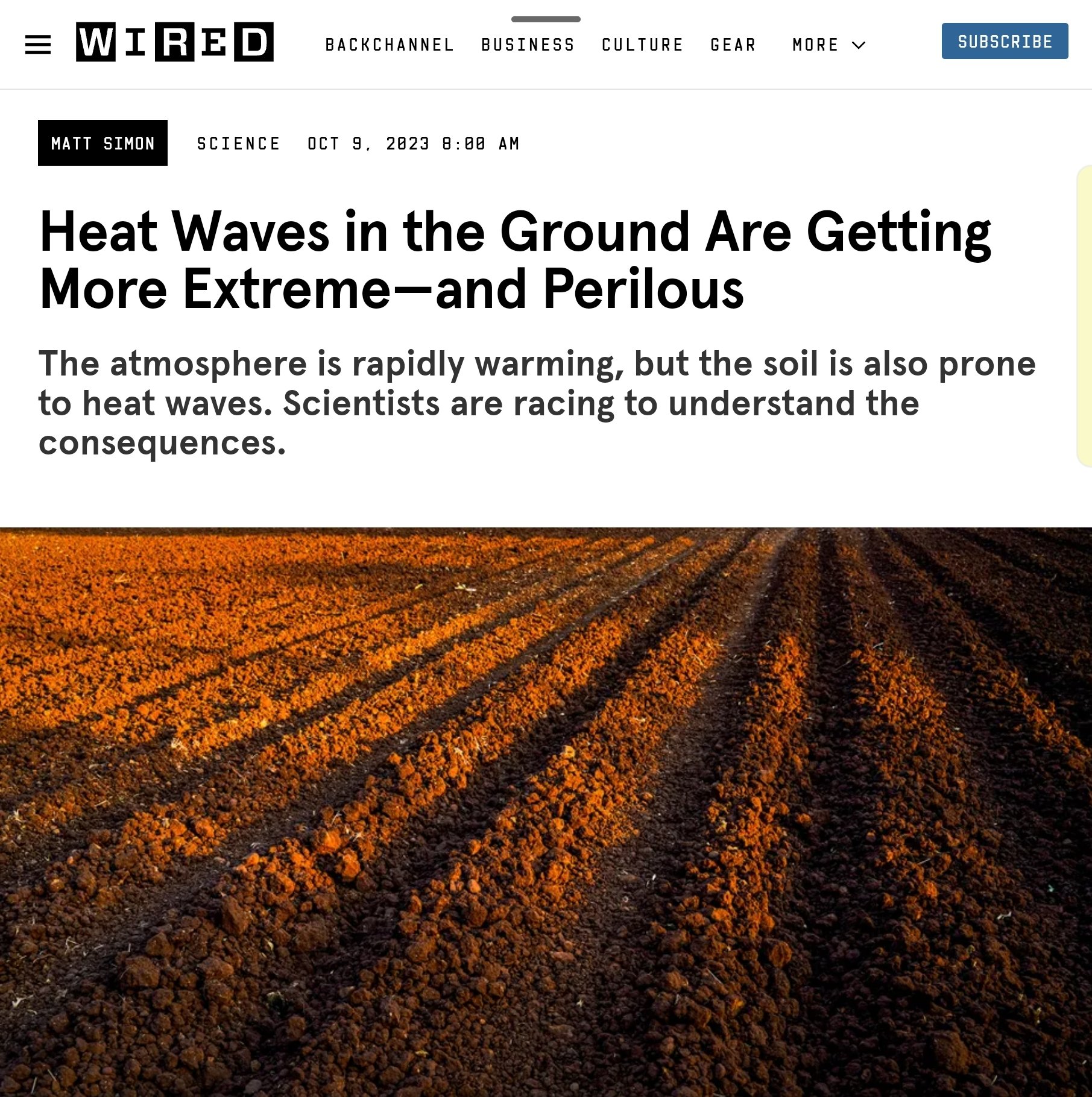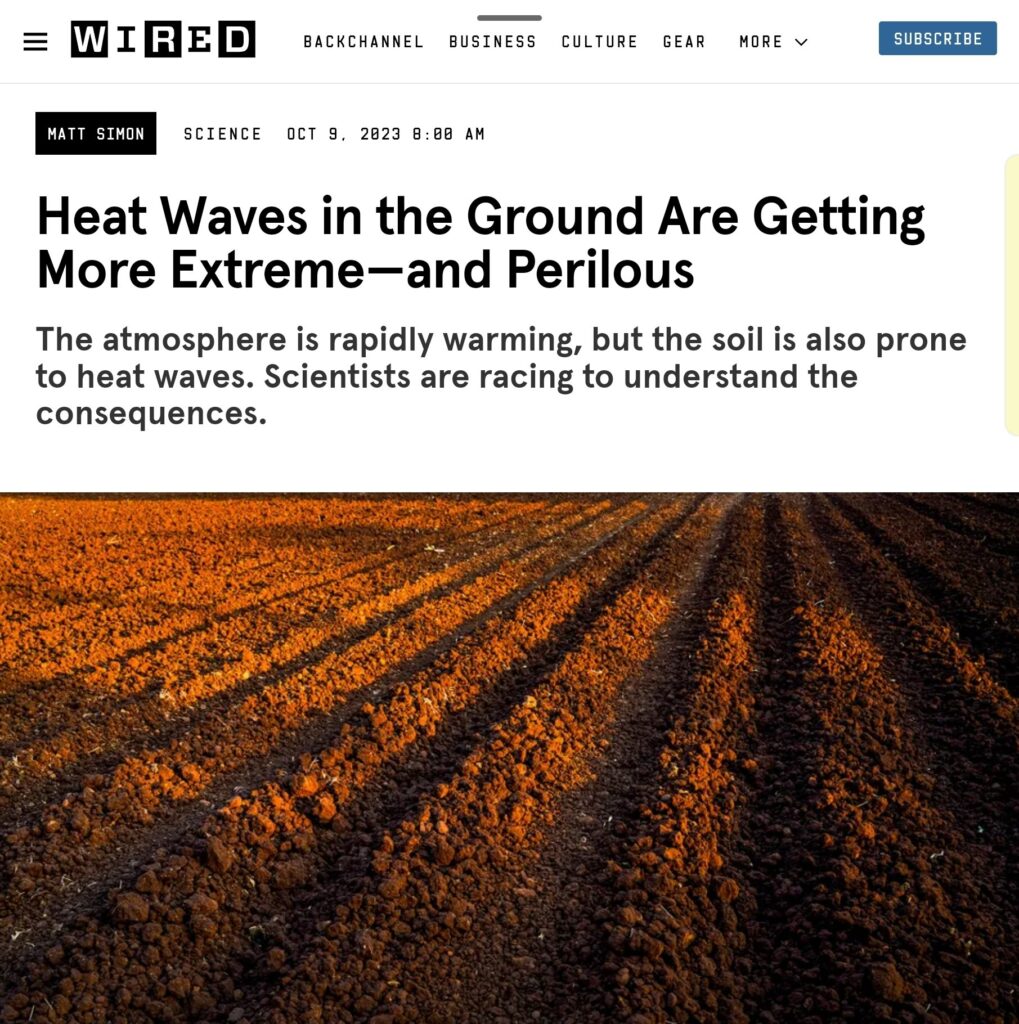A new climate fear!
Beware of boiling soil!
Your SUV is causing soil heatwaves!
Heat Waves in the Ground Are Getting More Extreme—and Perilous – The soil is also prone to heat waves | WIRED https://t.co/hiHpUcGPCk pic.twitter.com/G6TtHwVs2N
— Marc Morano (@ClimateDepot) October 22, 2023
https://www.wired.com/story/heat-waves-in-the-ground-are-getting-more-extreme-and-perilous/
UNLESS YOU’RE RUNNING around barefoot, you experience heat waves through air temperature. For the most part, that’s how scientists track them too. “Heat extremes have been always studied based on air temperature, in part because we have a lot of observations of air temperatures,” such as from meteorological stations, says Almudena García-García, an Earth system scientist at the Helmholtz Centre for Environmental Research.
But how heat waves are rippling through the ground is much less studied. This proliferation of heat could have major implications for the intricate natural systems that grow our food, process water, and even sequester carbon. At a certain point, warming soils could actually contribute to higher air temperatures, in a gnarly sort of climatic feedback loop.
Late last month, García-García published troubling findings in the journal Nature Climate Change about soil heat extremes across Central Europe. The team gathered data from 1996 to 2021 on air temperatures up to 2 meters (about 6 feet) off the ground, and temperatures in the same regions in the first 10 centimeters (or 4 inches) of soil. At two-thirds of the nearly 120 measuring stations they tapped into, heat extremes were growing more pronounced in the soil than in the air. Each decade, these extremes grew 0.7 degrees Celsius higher in the soil compared to the air. The number of days the soil experienced heat extremes increased twice as fast.
“This paper opens a lot of questions, because now we see that there are differences between the evolution of soil and air heat extremes,” says García-García. “Perhaps the difference between the evolution of heat events in soil, vegetation, and air can help us to understand or to predict agricultural failures, biodiversity changes, or any other climate-change impact on ecosystem activities.”
…
It’s even worse if there’s little water in the soil to begin with. “Another very important and also interesting perspective is compound events, so the combination of the heat waves and droughts,” says Jian Peng, an Earth observation scientist at the Helmholtz Centre for Environmental Research and coauthor of the new paper.
Both heat waves and droughts, of course, are getting worse with climate change. “Our climate models essentially predict that this contribution of low moisture of dry soils to heat extremes is only going to increase or strengthen in the future,” says ETH Zurich atmospheric scientist Dominik Schumacher, who studies the interaction between land and air but wasn’t involved in the new paper. “I think that the paper makes it a bit more clear that what happens in the ground— even though we don’t see it—definitely does matter.”
As the climate changes, so will the soils themselves, in all kinds of ways—organically, hydrologically, microbially. “Soils are in equilibrium, more or less,” says Margenot. “The non-pessimistic view is: Well, this is going to shift to new equilibrium. The problem is that we humans depend on soils for multiple services, like water storage and food production. Those might get caught up or disrupted in that new shift.”
Dry, hot conditions combined with soil that lacks organic matter also leads to erosion and dust emissions. (That’s what happened in the Dust Bowl.) Less agricultural growth also means less food is available for people.
Soil microbial communities will change, too—the galaxy of bacteria, viruses, fungi, and archaea in the ground. “Most of the diversity of fungi on the planet is in soil,” says soil microbial ecologist Kate Scow of UC Davis, who wasn’t involved in the new research. “Are any of these temperatures at the drop-dead temperature? Probably not. We’re not talking about that yet. But you’ll get changes in the diversity of the community.”
Some microbes might struggle with warming temperatures and decreasing soil moisture, so their numbers will fall. Others might grow more numerous. That will in turn influence the functions of those species. Some process carbon or phosphorus; others turn nitrogen into fertilizer for plants. Still others—the mycorrhizal fungi—form symbiotic relationships with plants, helping the roots take up water and nutrients in exchange for nutrients of their own.
Soil heat waves could become a kind of repetitive stress on these underground communities. “I wonder if over time,” says Scow, “if soils are increasingly hit again and again and again with high temperatures and big droughts, is it going to ratchet down the capacity for them to deal with future events?”
#
Wired Mag: ‘Heat waves are rippling through the ground’ – ‘Soil heat waves could become a kind of repetitive stress on these underground communities.’ – How heat waves are rippling through the ground is much less studied. This proliferation of heat could have major implications for the intricate natural systems that grow our food, process water, and even sequester carbon. At a certain point, warming soils could actually contribute to higher air temperatures, in a gnarly sort of climatic feedback loop. Late last month, García-García published troubling findings in the journal Nature Climate Change about soil heat extremes across Central Europe. …
“Our climate models essentially predict that this contribution of low moisture of dry soils to heat extremes is only going to increase or strengthen in the future,” says ETH Zurich atmospheric scientist Dominik Schumacher…
This proliferation of heat could have major implications for the intricate natural systems that grow our food, process water, and even sequester carbon. At a certain point, warming soils could actually contribute to higher air temperatures, in a gnarly sort of climatic feedback loop.




